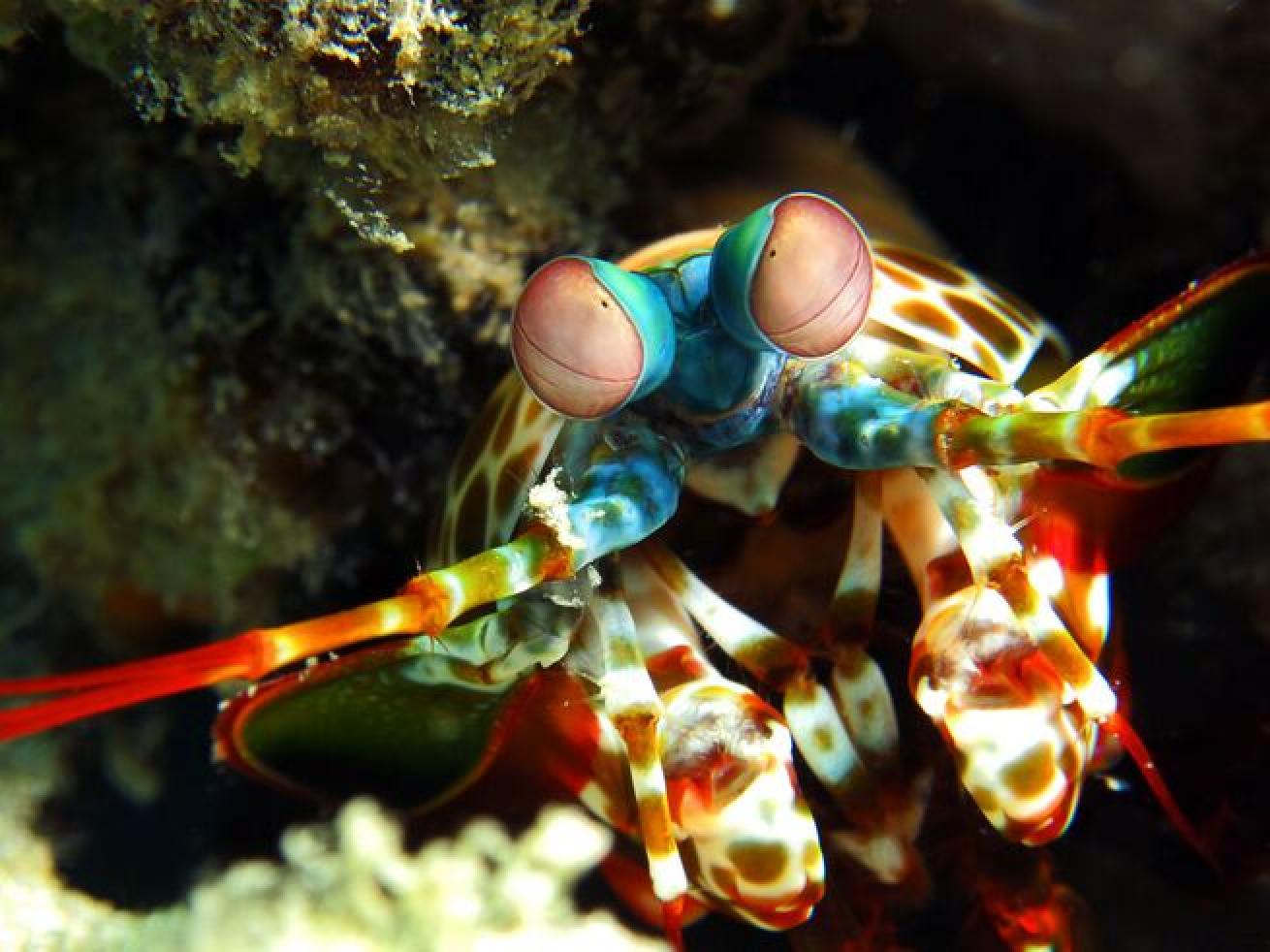What Happens When a Mantis Shrimp Packs a Punch?

ShutterstockA peacock mantis shrimp. There are two types of mantis shrimp, divided by the type of claw they possess.
They’re a favorite of underwater photographers—mantis shrimp, especially the colorful peacock mantis. They are also lethal predators, and well equipped to find and pulverize their prey.
But Superman vision is not the only thing mantis shrimp possess. Their front claws are also designed to make them effective killing machines.
“These specialized appendages produce one of the fastest recorded movements in the animal kingdom,” says Maya deVries, an assistant professor of biological sciences at San Jose State University.
There are two types of mantis shrimp, divided by the type of claw they possess. The “spearers” have spiny appendages with barbed tips to snag and stab prey. Spearers use their barbed claws to slice and snag the flesh of softer animals, such as fish. The “smashers” have bowling-ball-type clubs that they use to bludgeon prey or smash apart the shells of snails, crabs, mollusks and rock oysters. Both types can strike by unfolding and swinging their claws, but the smashers are capable of what’s believed to be the fastest strike on Earth.
A smasher mantis shrimp’s punch has the same acceleration as a 22-caliber bullet, delivering a blow of 15,000 newtons, a force equal to more than 2,500 times the shrimp’s weight. That power is pretty impressive, especially for such a little guy (most are in the 6-inch range, but they can measure between 4 and 15 inches). Their punch can easily break quarter-inch glass (they’ve been known to smash aquarium tanks).
How does such a tiny package deliver such a big punch? In layman’s terms, the shrimp’s arms are hinged and folded away under its head, ready to unfurl via a springlike latch. When unsuspecting prey happens by, the shrimp releases its latch, launching its lower arm forward at a rapid speed.
Related Reading: Discovering Patagonia's Winged Comb Jelly
In scientific terms, though, it’s a bit more complicated. Sheila Patek, deVries’ Ph.D. adviser, studies the lightning-fast biological movements of animals, including mantis shrimp and trapjaw ants. Now at Duke University, Patek was working at UC Berkeley when she first began looking at the biology, physics and engineering of the peacock mantis shrimp (Odontodactylus scyllarus). At the time, the shrimp’s latch-like mechanism—not unlike the triggerlike mechanism the Venus’ flytrap possesses—was unknown.
Patek began filming the shrimp, but she hit a snag. The high-speed video system she was using wasn’t fast enough to capture the shrimp’s punch accurately. A collaboration with a BBC crew filming for the series Animal Camera was Patek’s lucky break—the crew offered to lend her one of its super-high-speed cameras.
Patek captured footage of a peacock mantis’s strike, slowed down over 800 times. The findings amazed the researchers. With each punch, the claw’s club edge travels at about 50 mph, over twice as fast as scientists had previously estimated.
“We will film animals anywhere from 3,000 frames per second to 100,000 frames per second or more,” says deVries. “Once we have filmed the animals striking, we go back and we digitize the same points on the appendage in every video frame. This allows us to track the movement of the appendage in space and time. From these points, we can then calculate the speed and acceleration of the strike.”
Patek’s research also led to understanding the latch mechanism the crustaceans use to help them pulverize prey.
Related Reading: 7 Liveaboards to Book if You Love to Learn
“The mantis shrimp has an energy storage system where it cocks its arm,” explains deVries. “It has a latch system that locks it in place. This latch is muscle-controlled. So when the animal is ready to strike, it contracts its flexor muscles, which releases the latch. When the latch is released, all of the energy that was stored in the muscles and springlike exoskeleton of the merus segment of the mantis shrimp’s raptorial appendage gets released, and the propodus and hammerlike dactyl (the punching part) segments of the appendage rotate forward at incredible speeds and accelerations.”
Patel also made a second discovery: The shrimp’s unfortunate prey is actually hit twice. First by the shrimp’s claw and then by a shockwave caused by the rapid strike.
“Basically, the appendage is moving so fast through water that it creates an area of low pressure and an air bubble forms,” explains deVries. “When that air bubble implodes, it releases incredible amounts of energy. That phenomenon is called cavitation.”
The speed is measured in microseconds (one microsecond is equal to a millionth of second). The mantis shrimp’s punch? It happens in less than 80 microseconds. That’s 50 times faster than the blink of a human eye.
Read about deVries’ research on her website.
Learn more about Patek’s research at Patek Lab.










